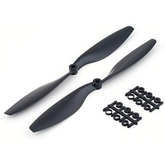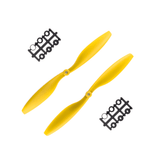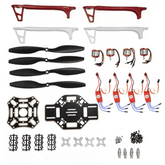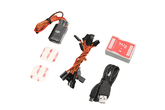Choosing the Right Propellers for Your Drone
Summary
Drones have become increasingly popular, and with that comes a need to understand how they work, including their propellers. Drone propellers are an essential component that determines a drone's speed, stability, and maneuverability.
This blog post covers topics such as how drone propellers work, which way they spin, how to choose the right propeller size, and what the numbers on drone propellers mean.
Additionally, the post discusses how long drone propellers last and provides helpful tips on extending their lifespan. Whether you're a beginner or an experienced drone pilot, this post offers valuable information to help you get the most out of your drone.
Drones are becoming increasingly popular for both personal and professional use, and a key component of these flying machines is the propeller. In this blog post, we'll take a closer look at drone propellers and how they work
What are drone propellers?
Drone propellers are rotating blades that provide lift and propulsion for drones. They are typically made of plastic or carbon fiber and are attached to motors on the drone.

How do they work?
Propellers work by spinning at high speeds to create thrust, which generates lift and propels the drone forward.
The spinning blades of the propellers create a difference in air pressure, with the air pressure being lower on the front of the blade than on the back. This difference in air pressure generates thrust, which propels the drone forward.
Types of drone propellers
- There are several types of drone propellers available, each with its unique characteristics and capabilities. Some common types include:
- Two-blade propellers: These propellers have two blades and are typically used on smaller drones. They are lightweight and efficient but can be less stable than other types of propellers.
- Three-blade propellers: These propellers have three blades and are typically used on larger drones. They are more stable than two-blade propellers but can be less efficient.
- Four-blade propellers: These propellers have four blades and are typically used on larger drones. They are more stable and efficient than two-blade or three-blade propellers.
read more : Drone Motor – Where to Begin?
Which way do they spin?
The direction in which a drone propeller spins is determined by the direction of rotation of the motor that powers it.
In most cases, drone propellers spin clockwise when viewed from the front of the drone. This is known as a "normal" rotation. Some drones use a "reverse" rotation, where the propellers spin counterclockwise.
The direction of rotation is usually determined by the design of the drone and the specific requirements of the application. It is important to note that for multirotor drones, all the propellers must spin in the same direction for the drone to function properly.

How to choose the right drone propeller?
Choosing the right drone propeller is important for ensuring the best performance and safety of your drone. Here are some key factors to consider when selecting a propeller:
- Size and weight of your drone.
- Type of application.
- Motor compatibility.
- Flight time.
- Speed.
- Durability.
- Noise
- Price.
read more : Drone Transmitter and Receiver Guide
When choosing the right drone propeller, it's important to consider all of these factors and choose a propeller that is best suited for your specific drone and application.
It's also important to follow the manufacturer's recommendations for propeller size and type to regularly inspect and maintain your propellers to ensure they are in good working condition.
Visit our Drone Controllers collection page for extensive controllers.
What size propeller do I need for my drone?
The size of the propeller you need for your drone will depend on the size and weight of your drone, as well as the specific requirements of your application.
Generally, larger drones will require larger propellers that can supply thrust to move the drone upwards with sufficient power, whereas the smaller drones might require smaller propellers which has a lower power that could serve the purpose.

read more : Best Flight Controller for Drone
What do drone propeller number mean?
A string of digits called a drone propeller number is used to identify the propeller. The majority, if not all, of the propeller's parameters, such as its length, pitch, rotation, and blade design, are identified by these numerals. But this figure is frequently presented in many ways.
If you don't know what the requirements indicate, a propeller number is useless. In fact, many pilots form false beliefs at the outset of their flight and stick with them.
This is why it is good to go through the specifications, primarily the length and pitch, before we learn about the formats of propeller numbers.

read more : All About Lithium Polymer Batteries (LiPo)
How long do they last?
The lifespan of a drone propeller can vary depending on the type of propeller, the environment in which it is used, and the level of use and maintenance. On average, most drone propellers have a lifespan of 500 flight hours or several months to a year based on the usage.
However, the lifespan of a propeller can be affected by several factors:
- Durability: Propellers made of durable materials such as carbon fiber or reinforced plastic have a longer lifespan compared to those made of cheaper materials.
- Flight conditions: Propellers that are flown in harsh conditions such as high winds, extreme temperatures, and heavy use will have a shorter lifespan than those flown in more mild conditions.
- Quality: High-quality propellers are often more durable and last longer than cheaper, low-quality propellers.
- Maintenance: Proper maintenance such as regular cleaning, inspection, and proper storage can prolong the lifespan of a propeller.
It is important to regularly check the condition of the propellers and replace them when they show signs of wear and tear. Damaged or worn propellers can affect the performance and safety of your drone, so it is important to replace them as soon as possible.
read more : Drone Motor Maintenance: Tips to Keep Your Motors Running
Conclusion:
Drone propellers are a crucial component of any flying machine, and understanding the different types, how they work, and how to choose the right one is important for ensuring the best performance and safety of your drone.
Propellers come in different shapes, sizes, and numbers of blades, each with its advantages and disadvantages. It's important to consider the size and weight of your drone, the type of application you will be using it for, and the specific requirements of your application when choosing a propeller.
Additionally, proper maintenance and regular inspection can help prolong the life of your propellers and keep your drone flying safely.
If you appreciate our work don't forget to share this post and leave your opinion in the comment box.
Please do check out other blog posts about Popular electronics
Check out other related blog posts about Drones: Drone transmitter and receiver , Drone Part List , Drone motors and Getting started with a Quadcopter
Make sure you check out our wide range of products and collections (we offer some exciting deals!)












